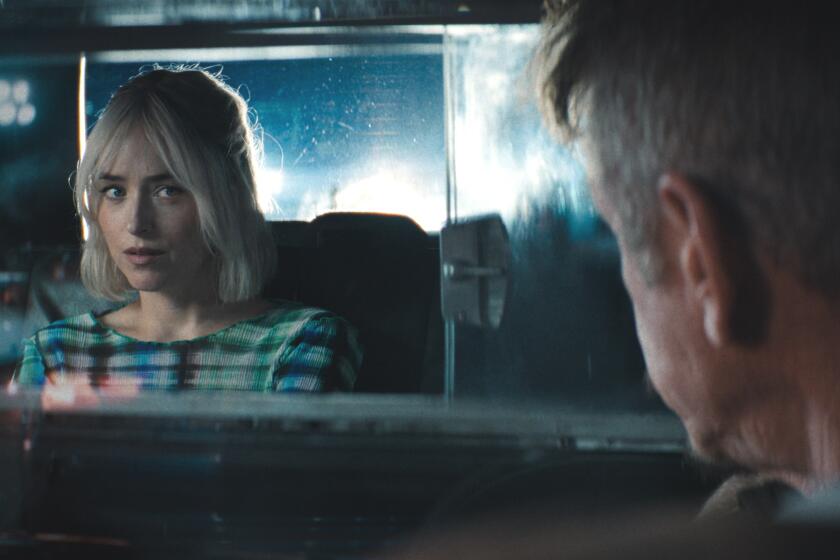Rage Against the Machines: ‘T3’s’ Rocky Road
In all of film history, there are few characters iconic enough to speak across generations and national divide. One of those is the Terminator, a grim hallucination from the future, a totem of invincible, implacable masculinity.
“Everybody on the planet can tell you the Terminator wears a black leather jacket,” says director Jonathan Mostow. “This character is so burned into our movie consciousness. There are very few mythologies that are known all over the world.”
Thus, imagine the glee that swept through the executive suites of Hollywood this past December as every studio head was invited to a secret hotel room meeting to read a new installment of the franchise, “Terminator 3: The Rise of the Machines,” and bid for the distribution rights to the film.
It didn’t matter that its star, Arnold Schwarzenegger, at 54, was an aging Terminator whose box office gross in recent films had fallen off faster that you can say “Hasta la vista.” It didn’t matter that its original writer-director, James Cameron, now the Academy Award winning writer-director of the highest-grossing film of all time, “Titanic,” had been replaced by Mostow, director of the submarine movie “U-571,” or that actress Linda Hamilton, who’d made delineated biceps a fashion must-have, wasn’t taking part. It didn’t even matter that it had been a decade since the last installment and its prime audience of teens was too young to have seen the first two during their theatrical runs.
All the studios (save for Fox, out of loyalty to Cameron) came and made offers and pitches. Almost never in film history has an established franchise been put up for sale. Though Hollywood has always been sequel-friendly, in the past year it’s become positively sequel mad, with sequels to “Men in Black,” “Lord of the Rings: Fellowship of the Ring” and “Harry Potter and the Sorcerer’s Stone” all heading for the box office. It’s not simply that Hollywood loves sure bets. In an industry where almost every studio is owned by a conglomerate, these kinds of franchises are not viewed just as movies but as perfect vehicles for corporate synergies--conceptual widgets to be plugged on cable and the Internet, through books and theme parks, records, and merchandising.
“Terminator 3” starts production next month, and if all goes according to plan, it will arrive in theaters in summer 2003, courtesy of Warner Bros. (here) and Sony (abroad). At a budget insiders put at $172 million, it is the most expensive independently financed movie ever made, although only roughly $90 million of that budget is going to actual physical production. Besides Schwarzenegger’s Terminator-size compensation (hovering in the $30 million range, depending how you count the perk package) and Mostow’s $5 million price tag, the rest of the money is going to the various rights-holders and backstage players.
It’s Hollywood’s equivalent of blood money, payment for surviving and winning what has been a byzantine struggle to make a film that involves a busted marriage, torched friendships and two producers beating their way back from Siberia. It’s taken all that effort to make sure that the Terminator once again utters his trademark aphorism: “I’ll be back.”
*
Creation of the Little
Sleeper That Could
Ironically enough, the first time Cameron sold the rights, it only cost a dollar and the price of ambition. Then a neophyte writer-director, the auteur of the little-seen “Piranha 2” had co-written the script with fledgling producer Gale Anne Hurd, his future wife. It is the story of a cyborg sent back from the future to kill an innocent woman whose unborn child will grow up to lead mankind in a revolution against sentient machines. Cameron sold Hurd his half of the rights, under the strict provision that he be allowed to direct.
The little $6.4 million sleeper grossed a modest $36.9 million in 1984 but launched both his and Schwarzenegger’s careers.
Hemdale, the company that made the film, went bankrupt in 1992. The high-flying independent Carolco Pictures, purveyor of the “Rambo” series (for which Cameron penned “Rambo: First Blood Part 2”), which had already snatched up Hemdale’s portion of the rights for $10 million, paid $7 million to Hurd, now Cameron’s ex-wife, for her rights, and together with Cameron fashioned “Terminator 2: Judgment Day.” At the price of about $113 million, then the most expensive movie ever made, the film nearly capsized the company but went on to be a juggernaut, grossing $517 million worldwide, winning four Academy Awards and breaking new ground in special effects.
Then Carolco Pictures, beset by a series of bombs such as “Showgirls” and “Cutthroat Island,” went bankrupt in 1995, and it was at the Carolco bankruptcy auction in October 1997 that a 50% share in the franchise came up for sale and the current saga began.
On that day in 1997, a number of interested parties turned out to take part in the bidding, from Miramax’s Bob Weinstein to Hurd, who maintained the other 50% of the rights. . Cameron was in the throes of finishing “Titanic,” but his interests were represented by an attorney from Fox, the studio which was making “Titanic.”
*
In Court, a Diverse
Cast of Characters
Ever since Carolco had begun to flounder in 1995, Fox chairman Bill Mechanic had been meticulously assembling a deal for “Terminator 3” in which Cameron, Schwarzenegger and Hurd would forgo much of their hefty upfront fees for a bigger piece of back-end profits. Cameron had committed only to writing and producing. “He was uncertain if he’d direct it, although he reserved the right to direct it,” says Rae Sanchini, president of Cameron’s company, Lightstorm Entertainment. (Cameron declined to comment for this article.) “He wanted to be involved in shepherding it and making sure it was done right. He wanted to be there for Arnold.”
Perhaps the most surprising attendees were Mario Kassar and Andy Vajna, the co-founders of Carolco Pictures recently reunited as business partners after an eight-year separation.
More than anyone, the Lebanese-born Kassar had been responsible for the demise of Carolco, through poor movie choices and lavish spending. He was famous for cruising the Cannes Film Festival in a 200-foot yacht. When Schwarzenegger wanted a plane in lieu of salary on “Terminator 2,” Kassar bought him a nifty $14 million Gulfstream III.Indeed, it had been Kassar’s open-wallet policies that had initially driven a wedge between him and Hungarian business partner Vajna, leading Kassar to buy out Vajna’s shares in the company in 1989 for a reported $107.5 million. His film ambitions were in the midst of crumbling and at auction time, he was dissolving his company Cinergi, which had produced “Die Hard With a Vengeance” as well as such bombs as 1995’s “The Scarlet Letter.” A federal grand jury was also investigating both men’s 1980s tax returns.
Still, both men had remained close to Cameron, close enough that he’d recently invited them to see an early edit of “Titanic” and have a meal afterward.
Neither mentioned an interest in “Terminator 3,” so the director was reportedly shocked and furious to hear that within days, the pair had made a deal with bankruptcy court to snatch Cameron’s baby out from under him, paying $7.5 million for Carolco’s 50% rights to the franchise and the opportunity to match any higher bids at the auction.
Vajna claims that he’d never considered buying “Terminator” until that foray to see “Titanic.” “The whole idea came as a result of that screening,” says the producer. “We found that the rights for ‘Terminator’ were still there and nobody had ever made a bid for it.” “All I knew is that Jim felt this was his creation, and why were they interfering in the process?” recalls Mechanic, who was on the phone with Cameron as the Fox attorney representing Cameron’s interests stood by in the courtroom that day in 1997. “It had been John Daly at Hemdale who’d made the first movie, not Mario and Andy. They did the second. Mainly this was [Cameron’s] work. He was the guy to do it or not to do it.” Mechanic asked Cameron if he wanted the studio to top the bid, but Cameron said he “didn’t want to be in it.”
“I felt he was only hanging in there at the end because of Arnold and quality control. It was something that Arnold always wanted to do again. Period. And Jim was more than happy to do it.”
By several accounts, Cameron was furious with Kassar and Vajna, a fury that permanently damaged their once close relationship. Vajna says he called both Cameron and Schwarzenegger that night to try to right the situation and professes amazement that Cameron should be angry.
“What difference does it make to Jim who’s financing the movie, a studio or us?” Vajna says. “His deal would have been the same. Arnold tried to convince Jim over a long period of time to do the film. Arnold felt very loyal.”
More discussion between Fox and Kassar and Vajna followed. Mechanic, who was then chairman of the studio, says the talks were never serious. Vajna says the studio tried to buy the rights from them for Cameron. “They made a proposal. We accepted, but it fell apart over chain of title issues.” Sanchini says the hiccup came over the fact that Kassar and Vajna had sold off rights in Germany and Japan, the two biggest territories outside of the U.S. (According to production sources, Vajna and Kassar ultimately paid Hurd $7 million for her rights.)
“It was not an easy decision for Jim to walk away from ‘Terminator,’” says Sanchini. “He felt great ownership of the material even though he in fact never owned it.”
Indeed, before Schwarzenegger signed on he came to see Cameron to ask for his blessing--and, according to Sanchini, received it.
*
The Power of a Star
and a Signature Franchise
Schwarzenegger’s box office appeal is not what it used to be, but he’s consistently been a bigger draw overseas. Indeed, 1991’s “Terminator 2” was one of the first films to prove the rising force of the international box office. The film earned $200 million here and $300 million abroad. Still, his recent numbers have been on a downward spiral. . His latest film, “Collateral Damage,” has grossed only $37 million here.
Schwarzenegger as the Terminator, however, provokes a different reaction. According to a studio representative, when Schwarzenegger recently dropped by a sales conference at Sony, which will distribute the film internationally, the foreign exhibitors went nuts.
Mostow, whom Kassar and Vajna tapped to replace Cameron, says, “Obviously, I’d be lying to say it wasn’t daunting working in his shadow. The bar has been set very high.”
There’s still Schwarzenegger to provide authentic Terminator wisdom, says Mostow. “I feel like I’m making the Bible and I’m getting to work with Moses. If there’s any question about the Terminator, you’ve got Arnold to talk to. He’s lived with this character for 17 years.”
Mostow has spent much of the last year holed up with screenwriters Mike Ferris and John Brancato (“The Net”), friends from his college days at Harvard, reworking an early draft of the script by Tedi Sarafian, which had been roundly panned on the Internet Web site Ain’t It Cool News.
Ironically enough, it was the power of the Internet that helped Warner Bros. secure the domestic rights to the film for $50 million plus close to that amount in prints and advertising. These rights include the lucrative DVD and video market.
Their winning pitch involved promotional plugs on America Online as well as what can only be called a “Matrix” sandwich. Of all films set for 2003 release, Warner’s two “Matrix” sequels, with their mystical sci-fi martial arts bent, loomed in the minds of the “T3” team as their biggest competition. That threat has now been neutralized--”T3” will arrive in theaters on the heels of “Matrix 2,” set for a spring release, and before “Matrix 3,” to arrive over the holidays.
Still, one question remains. With all the worldwide rights sold for $145 million, that still leaves a $25 million budget shortfall to be covered by Vajna, Kassar and their partner, Intermedia, an entertainment investment company. They expect to reap their rewards through the merchandising rights and bonuses, when and if the film reaches certain box office plateaus.
Says Vajna, “We believe ‘Terminator 3’ will reignite Mario’s and my partnership.”
More to Read
Only good movies
Get the Indie Focus newsletter, Mark Olsen's weekly guide to the world of cinema.
You may occasionally receive promotional content from the Los Angeles Times.






